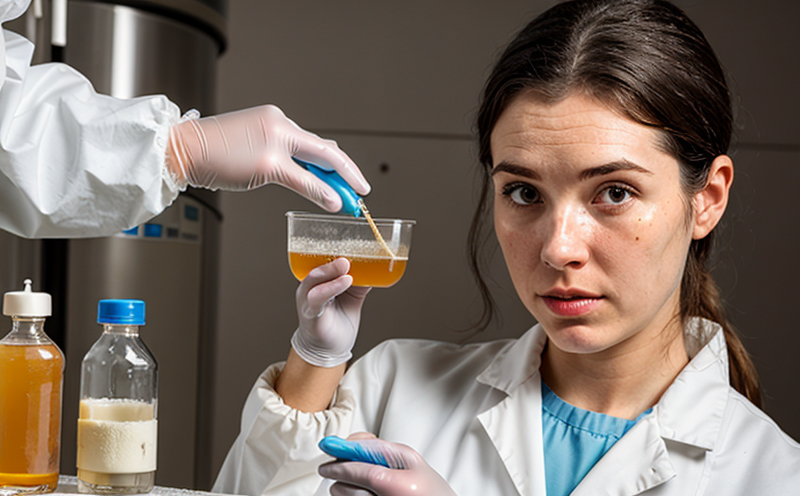EP 2.6.12 Microbial Examination Including Fungal Identification
The European Pharmacopoeia (EP) 2.6.12 specifies a comprehensive method for examining microorganisms, including the identification of fungi. This service is crucial in ensuring product purity and safety in pharmaceuticals and biotechnology sectors. The examination involves a series of steps designed to identify potential contaminants that could compromise the efficacy or stability of a formulation.
The process begins with sample collection, which must be sterile and representative of the material being tested. Samples are then inoculated onto appropriate media such as Sabouraud Dextrose Agar (SDA) for fungal growth and MacConkey agar for bacterial colonies. Incubation periods vary depending on the type of microorganism expected.
Once visible colonies appear, they undergo microscopic examination using light microscopy or scanning electron microscopy to observe morphological characteristics like size, shape, color, and texture. This helps in distinguishing between different genera and species.
Further identification requires more advanced techniques such as API strips for bacteria or biochemical tests specific to fungi. Molecular methods including PCR (Polymerase Chain Reaction) may also be employed where necessary. These molecular approaches provide rapid results with high specificity.
For accurate reporting, it's essential to compare microscopic findings with reference databases like Bergey’s Manual of Systematic Bacteriology or the Fungal Database maintained by the U.S. National Center for Biotechnology Information (NCBI). This ensures that all identified organisms are correctly classified according to current taxonomic standards.
The results from this examination play a critical role in ensuring compliance with regulatory requirements set forth by bodies such as the European Medicines Agency (EMA), US Food and Drug Administration (FDA), World Health Organization (WHO), etc. They also support quality control measures aimed at maintaining product integrity throughout its lifecycle.
By adhering strictly to EP 2.6.12 guidelines, laboratories like ours provide reliable data that helps manufacturers make informed decisions about their products' safety and efficacy. Our expertise guarantees accurate identification of microorganisms present in samples submitted for testing.
In summary, EP 2.6.12 microbial examination is an indispensable tool used across various industries to safeguard public health by preventing the introduction of harmful contaminants into pharmaceuticals or other controlled substances.
- EP 2.6.12 requires strict adherence to a set protocol for sampling and processing samples.
- The use of appropriate media allows for optimal growth of target organisms.
Eurolab Advantages
At Eurolab, we offer unparalleled expertise in EP 2.6.12 microbial examination services that go beyond mere compliance. Our team comprises highly skilled microbiologists who understand the nuances of this complex field and can provide actionable insights based on their findings.
- Comprehensive Expertise: Our scientists possess extensive knowledge not only in identifying microorganisms but also understanding how they might impact different types of products.
- Innovative Approaches: Utilizing state-of-the-art technology, including advanced imaging techniques and molecular biology tools, we ensure accurate identification even when dealing with difficult-to-identify species.
- Regulatory Compliance: By staying up-to-date with the latest changes in regulations, we help our clients avoid costly mistakes while ensuring they meet all relevant standards.
- Timely Delivery: We pride ourselves on delivering reports within agreed timelines, allowing for swift decision-making processes that can positively impact business operations.
We are committed to providing exceptional service tailored specifically to your needs. Whether you require routine testing or need specialized analysis, our dedicated professionals will work closely with you to achieve the best possible outcome.
International Acceptance and Recognition
- European Medicines Agency (EMA): EP 2.6.12 is recognized by EMA as part of their guidelines for ensuring pharmaceutical quality.
- US Food and Drug Administration (FDA): Compliance with this standard supports FDA requirements for drug development and manufacturing practices.
- World Health Organization (WHO): WHO recommendations often align closely with EP standards, making our services globally applicable.
- International Standardization Organization (ISO): While ISO does not have a direct equivalent to EP 2.6.12, its principles underpin many international health and safety protocols that incorporate similar methodologies.
The widespread acceptance of these methods ensures that the results obtained from our laboratory are valid and reliable both within Europe and internationally.
Environmental and Sustainability Contributions
Incorporating EP 2.6.12 into environmental monitoring programs can lead to significant improvements in sustainability practices. By identifying potential sources of contamination early on, industries can take proactive measures to reduce their ecological footprint.
- Preventative Measures: Early detection allows for targeted interventions before widespread environmental impact occurs.
- Economic Benefits: Avoiding costly recalls and legal disputes by ensuring product purity saves resources both financially and environmentally.
Beyond just pharmaceuticals, this service has applications in agriculture, food processing, cosmetics, and more. Ensuring that all products meet stringent microbial standards contributes to overall environmental health.





